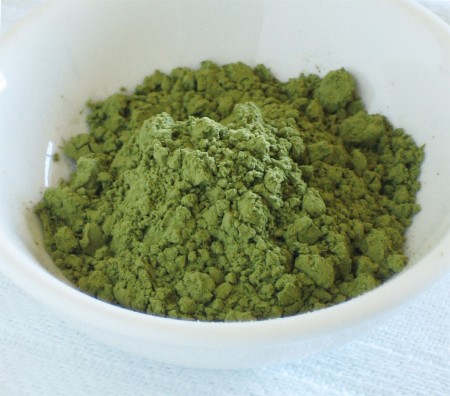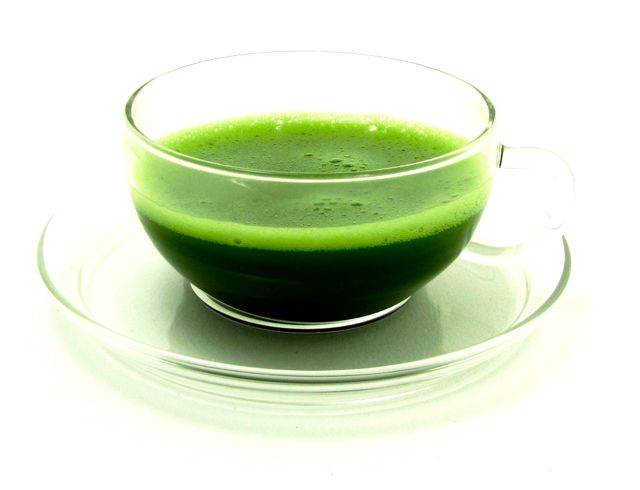Matcha is a fine ground, powdered, high quality green tea and not the same as tea powder or green tea powder. Matcha is also used to flavour and dye foods such as mochi and soba noodles, green tea ice cream and a variety of wagashi. Blends of matcha are given poetic names called chamei (“tea names”) either by the producing plantation, shop or creator of the blend, or by the grand master of a particular tea tradition. When a blend is named by the grand master of some tea ceremony lineage, it becomes known as the master’s konomi, or favoured blend. – from Wikipedia
Production
Matcha is made from shade-grown tea leaves. Several weeks before harvest, tea bushes are covered to prevent exposure to direct sunlight. This slows down growth, turns the leaves a darker shade of green and causes the production of amino acids that make the resulting tea sweeter. Then only the finest tea buds are picked. After harvesting, if the leaves are rolled out before drying as usual, the result will be gyokuro (jade dew) tea. If the leaves are laid out flat to dry, they will crumble somewhat and become known as tencha. Tencha can then be de-veined, de-stemmed, and stone ground to the fine, bright green, talc-like powder which is known as matcha.
It can take up to one hour to grind 1 ounce of matcha.
Note that only ground tencha qualifies as matcha, and other powdered green teas, such as powdered sencha, are known as konacha.
The highest grades of matcha have more intense sweetness and deeper flavour than the standard or coarser grades of tea harvested later in the year.
The most famous matcha-producing regions are Uji in Kyoto, Nishio in Aichi, Shizuoka, and northern Kyushu.
Grades
Matcha is generally expensive compared to other forms of tea, although its price depends on its quality. Grades of matcha are defined by many factors.
- Location on the tea bush – Where leaves destined for tencha are picked on the tea bush is vital. The very top would have developing leaves that are soft and supple. This gives a finer texture to higher grades. More developed leaves are harder, giving lower grades a sandy texture. The better flavor is a result of the plant sending all its nutrients to the growing leaves.
- Treatment before processing = Tencha leaves are traditionally dried outside in the shade and are never exposed to direct sunlight. Modern drying has mostly moved indoors. Quality matcha is vibrantly green also as a result of this treatment.
- Stone grinding – Stone grinding is an art form in itself. Without the right equipment and technique, matcha can become “burnt” and suffer degraded quality.
- Oxidation – Oxidation is also a factor in determining grade. Matcha exposed to oxygen can easily become compromised. Oxidized matcha has a distinctive hay-like smell and a dull brownish green color.
Health Benefits
The health benefits of green tea and matcha are widely acclaimed. Consequently, matcha and green tea can be found in health food products ranging from cereal to energy bars. In 2003, researchers from the University of Colorado found that the concentration of the antioxidant EGCG available from drinking matcha is up to 137 times greater than the amount of EGCG available from other commercially available green teas. Matcha is said to boost metabolism and not just because of the caffeine which is 1/2 the amount found in coffee. It is known to also help reduce cholesterol levels when consumed regularly. The aforementioned health benefits of matcha green tea can largely be attributed to the fact that the whole tea leaf is ingested, as opposed to just the steeped water in the case of ‘bagged’ green teas. This means that it delivers a much higher potency of catechins, chlorophyll, and antioxidants. Matcha contains more antioxidants than blueberries, gojiberries, pomegranates, orange juice, and spinach.
There is evidence from clinical studies that suggests that theanine, when consumed by drinking Japanese green teas, may help to reduce or moderate mental stress responses.
Research has also shown that the EGCGs which are a group of antioxidants called catechins, speed up the metabolism, helping the body burn stored body fat. Not to mention it significantly delays the onset of cancer as well as reducing the risk of cardiovascular disease. 1 All antioxidants inhibit the aging process by restoring cell tissue and reducing inflammation.
As far as caffeine goes, Green tea contains tannin witch slows the absorption of caffeine into the blood releasing it over the course of 6-8 hours, unlike coffee.
Better to be deprived of food for three days than tea for one – Ancient Chinese Proverb
Matcha tea is now available from the Farm Store here. Don’t worry, the price through the Farm Store is no higher than any other price from Amazon.com – Jughandle




5 comments
I’m thinking I am going to try this stuff……
Let us all know what you think. I’m putting in my order tomorrow.
[…] Also see – Matcha Green Tea […]
[…] version of the stuff the “older guys” warned me about. I am enjoying my first cup of Matcha – Green Tea as I write this post. I have already started my day with a pot of my favorite black tea, Lapsang […]
I have to say, youve got 1 with the ideal blogs Ive seen in a lengthy time. What I wouldnt give to be able to make a weblog thats as fascinating as this. I guess Ill just have to keep reading yours and hope that one day I can write on a subject with as a lot understanding as youve got on this 1!